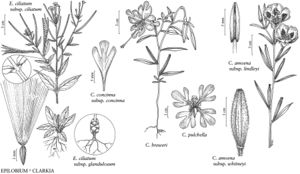Epilobium ciliatum subsp. glandulosum
Ann. Missouri Bot. Gard. 64: 136. 1977.
Herbs usually with large (5–12 mm), condensed, subsessile turions 1–10 cm below-ground, leaving dark scales, rarely with rosettes of fleshy leaves. Stems 20–110 (–170) cm, thick, simple or sparsely branched distally, subglabrous proximal to inflorescence with raised strigillose lines from margins of petioles, densely mixed strigillose and glandular puberulent distally, or rarely villous throughout. Leaves: petiole 0–4 (–10) mm; blade obovate to broadly elliptic proximally, usually narrowly ovate to ovate or broadly elliptic, rarely lanceolate distally, 3–10.5 (–16) × 1–4.5 (–5.5) cm, apex obtuse to subacute; bracts usually not much reduced. Inflorescences erect racemes, simple or sometimes branched, congested, 5–60 (–85) cm. Flowers: floral-tube 1–2.6 × 1.4–3.5 mm; sepals 4.5–7.5 × 1.2–1.8 mm; petals usually rose-purple to pink, rarely white, 4.5–12 (–14) × 2.5–6.3 mm; filaments white or cream to purple, those of longer stamens 3–6.5 mm, those of shorter ones 1.4–4.3 mm; style 2.4–8.2 mm, stigma 1.2–2.3 × 0.6–1 mm, sometimes exserted beyond anthers. Capsules 40–85 mm, mixed strigillose and glandular puberulent; pedicel 5–25 mm, rarely subsessile. Seeds 1.1–1.6 (–1.9) × 0.4–0.6 mm, chalazal collar 0.05–0.3 × 0.2–0.4 mm. 2n = 36.
Phenology: Flowering May–Sep.
Habitat: Damp banks of streams and lakes, seeps, wet meadows in montane, subalpine and maritime areas.
Elevation: 0–3400 m.
Distribution
St. Pierre and Miquelon, Alta., B.C., Man., N.B., Nfld. and Labr., N.W.T., N.S., Nunavut, Ont., P.E.I., Que., Sask., Yukon, Alaska, Calif., Colo., Idaho, Maine, Mass., Minn., Mont., Nev., N.H., N.Mex., Oreg., Utah, Vt., Wash., Wis., Wyo., e Asia (Russian Far East)
Discussion
Subspecies glandulosum has a geographical range almost entirely within the larger range of subsp. ciliatum. Despite this overlap, the two taxa tend to grow in different habitats and are only rarely functionally sympatric, with subsp. glandulosum in cooler, more stable habitats, often at higher elevations, and subsp. ciliatum in drier, more disturbed and open habitats. Where they occur in close sympatry, they sometimes intergrade, broadening each other’s overall variability. In northern Canada and Alaska, subsp. glandulosum tends to replace subsp. ciliatum, notably along coastal Alaska, where it also replaces subsp. watsonii. In Nunavut, subsp. glandulosum is known only from Akamiski Island in James Bay.
As discussed under 30. Epilobium luteum, subsp. glandulosum hybridizes with that species—both have relatively large flowers that promote outcrossing—resulting in the distinctive hybrid, E. ×treleasianum, which has very notably large, pink flowers. Hybrids formed with other sympatric taxa are less obvious, but can be detected by both reduced seed set and intermediate morphology.
Epilobium adenocaulon Haussknecht var. cinerascens (Piper) M. Peck is an illegitimate name that pertains here.
Selected References
None.
Lower Taxa
"narrower" is not a number.
